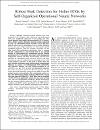Motion Artifacts Correction from EEG and fNIRS Signals Using Novel Multiresolution Analysis
| المؤلف | Hossain, Md. Shafayet |
| المؤلف | Reaz, Mamun Bin Ibne |
| المؤلف | Chowdhury, Muhammad E. H. |
| المؤلف | Ali, Sawal H. M. |
| المؤلف | Bakar, Ahmad Ashrif A. |
| المؤلف | Kiranyaz, Serkan |
| المؤلف | Khandakar, Amith |
| المؤلف | Alhatou, Mohammed |
| المؤلف | Habib, Rumana |
| تاريخ الإتاحة | 2023-04-17T06:57:44Z |
| تاريخ النشر | 2022 |
| اسم المنشور | IEEE Access |
| المصدر | Scopus |
| الملخص | Physiological signal measurement and processing are increasingly becoming popular in the ambulatory setting as the hospital-centric treatment is moving towards wearable and ubiquitous monitoring. Most of the physiological signals are highly susceptible to various types of noises, especially movement artifacts. The electroencephalogram (EEG) and functional near-infrared spectroscopy (fNIRS) signals are no exception to motion artifacts, which become prominent in the ambulatory setting. Since successful detection of various neurological disorders is greatly dependent upon clean EEG and fNIRS signals, it is a matter of utmost importance to remove motion artifacts from these two signal modalities using reliable and robust methods. This paper proposes three novel multiresolution analysis techniques: i) Variational mode decomposition (VMD), ii) VMD in combination with principal component analysis (VMD-PCA), and iii) VMD in combination with canonical correlation analysis (VMD-CCA), for motion artifact correction from single-channel EEG and fNIRS signals. The efficacy of these novel techniques is validated by computing the difference in the signal to noise ratio ( $\Delta SNR$ ) and percentage reduction in motion artifacts ( $\eta$ ). Among the three proposed novel methods, VMD-CCA decomposed with 15 intrinsic mode functions (IMFs) has shown the best denoising performance for EEG signals producing an average $\Delta SNR$ and $\eta $ values of 23.81 dB and 57.01%, respectively for all 23 EEG recordings. On the other hand, for the available 16 fNIRS recordings, VMD-CCA decomposed with 10 IMFs produced an average $\Delta SNR$ and $\eta $ values of 15.97 dB and 39.01%, respectively. The results reported using the proposed methods outperform most of the existing state-of-the-art techniques. 2013 IEEE. |
| اللغة | en |
| الناشر | Institute of Electrical and Electronics Engineers Inc. |
| الموضوع | canonical correlation analysis (CCA) electroencephalogram (EEG) functional near-infrared spectroscopy (fNIRS) Motion artifact principal component analysis (PCA) variational mode decomposition (VMD) |
| النوع | Article |
| الصفحات | 29760-29777 |
| رقم المجلد | 10 |
الملفات في هذه التسجيلة
هذه التسجيلة تظهر في المجموعات التالية
-
الهندسة الكهربائية [2840 items ]



